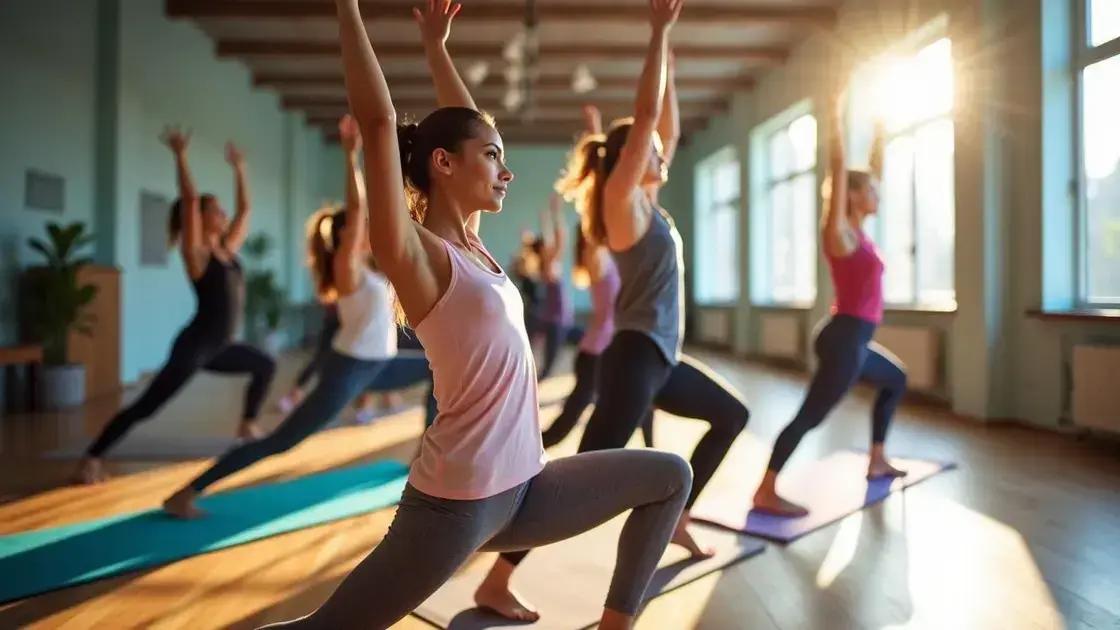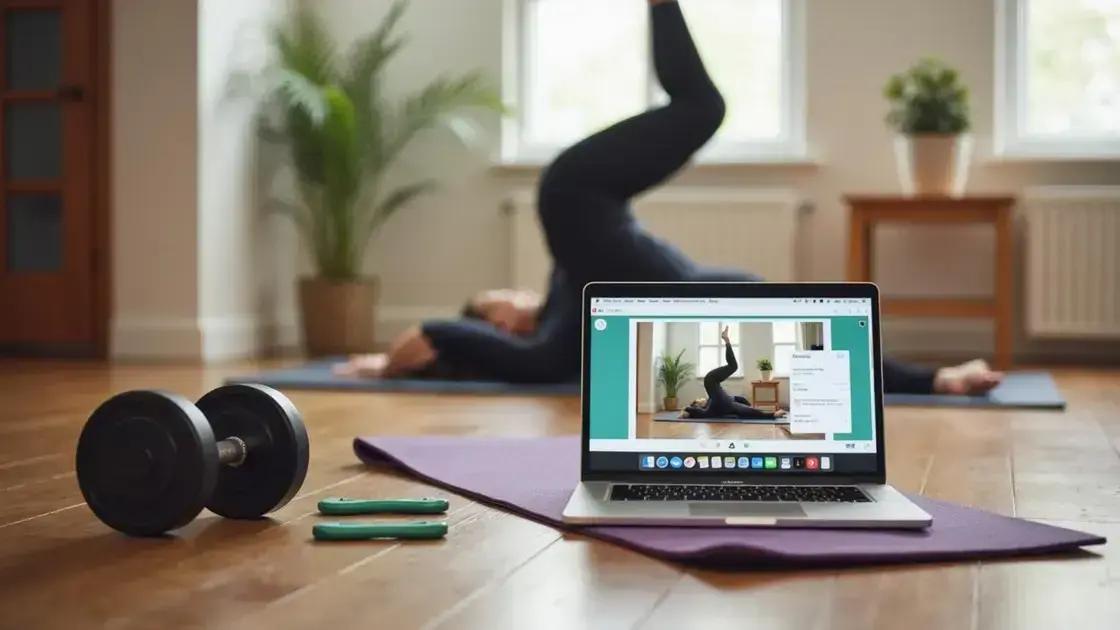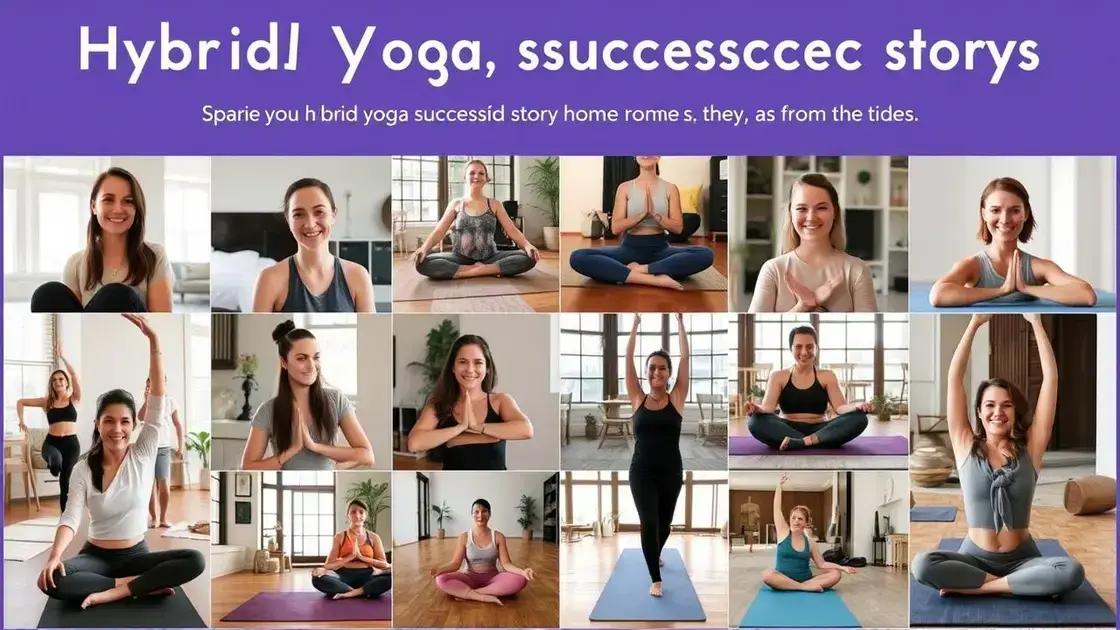Hybrid yoga workouts combine strength training and flexibility exercises, offering a comprehensive fitness approach that enhances overall health, reduces injury risks, and improves athletic performance for practitioners of all levels.
Hybrid yoga workouts are transforming how we approach fitness, merging strength training and flexibility into one dynamic practice. These innovative routines cater to individuals seeking to improve their overall fitness by enhancing strength and flexibility simultaneously. In this article, we will delve into the concept of hybrid yoga, explore its benefits, and provide guidance on how to start incorporating these workouts into your daily routine.
Understanding Hybrid Yoga Workouts

Hybrid yoga workouts combine traditional yoga with other forms of exercise, creating a versatile fitness option. This blend allows practitioners to engage both their strength and flexibility. Understanding the essence of hybrid yoga is essential for anyone looking to enhance their workout routine.
What is Hybrid Yoga?
Hybrid yoga typically integrates strength training methods such as weight lifting, Pilates, or bodyweight exercises. By fusing these elements, trainers can craft sessions that promote overall fitness while addressing the body’s need for flexibility and strength. It offers a balanced approach, targeting various muscle groups and enhancing athletic performance.
Why Choose Hybrid Yoga Workouts?
Opting for hybrid yoga workouts can bring numerous advantages. Not only do they enhance flexibility and strength, but they also increase cardiovascular endurance. This workout style keeps the body engaged and promotes a healthy balance between muscle engagement and lengthening.
Components of a Hybrid Yoga Workout
Typically, a hybrid yoga session may start with yoga poses to warm up the body. Following that, strength exercises might be incorporated. This can include push-ups, planks, or weight training. The session often concludes with restorative stretches, promoting recovery and flexibility.
Who Can Practice Hybrid Yoga?
Hybrid yoga is suitable for all fitness levels. Beginners find it helps improve strength and flexibility gradually. Advanced practitioners can use it to challenge themselves further and prevent workout monotony. Essential to this practice is the focus on proper alignment and mindful movement.
Benefits of Combining Strength and Flexibility

Combining strength and flexibility through hybrid yoga offers numerous benefits for both the body and mind. When these two elements work together, they create a well-rounded fitness experience that enhances overall physical health.
Enhanced Muscle Performance
Building strength helps your muscles perform better in any activity. When you add flexibility training, it allows muscles to work through their full range of motion. This combination leads to greater muscle efficiency and performance.
Reduced Risk of Injury
Hybrid yoga workouts can lower the chance of injuries. By improving flexibility, your muscles and joints become more resilient. Strength training supports muscle stability, which protects vulnerable areas of the body during physical activities.
Better Posture and Alignment
Strengthening core muscles while enhancing flexibility helps improve posture. Good posture reduces strain on the spine and joints, making everyday movements easier. This is especially important for those who sit for long periods.
Increased Overall Fitness
A balance of strength and flexibility leads to improved overall fitness. This means better performance in various physical activities, from sports to daily tasks. Additionally, it promotes better circulation and heart health, contributing to a stronger body.
How to Incorporate Hybrid Yoga in Your Routine

Incorporating hybrid yoga into your routine can be simple and rewarding. Here’s how to get started and make the most of your workouts.
1. Schedule Regular Sessions
To see results, plan your hybrid yoga workouts into your schedule. Aim for at least two to three sessions per week. Consistency is key to building strength and flexibility.
2. Start with a Balanced Routine
Begin your sessions with a mix of yoga poses and strength training. For example, you can start with Sun Salutations to warm up, then proceed to bodyweight exercises like push-ups or lunges, and finish back with calming yoga stretches.
3. Listen to Your Body
Pay attention to how your body feels during your workouts. It’s important to challenge yourself, but avoid pushing too hard. Allow time for recovery between workouts, especially when you’re new to hybrid yoga.
4. Join a Class or Use Online Resources
Consider joining a hybrid yoga class or using online videos. This way, you can learn proper techniques from qualified instructors and stay motivated by practicing with others.
5. Adapt as You Progress
As your strength and flexibility improve, adapt your routine to keep it challenging. Increase the intensity, try new poses, or add more strength exercises. This helps you avoid plateaus and keeps your practice enjoyable.
Success Stories from Hybrid Yoga Practitioners

Many individuals have transformed their lives through hybrid yoga. These success stories show the range of benefits seen by practitioners from diverse backgrounds.
Maria’s Journey
Maria, a busy mom of three, struggled with stress and fatigue. After starting hybrid yoga, she noticed a huge improvement in her energy levels and outlook on life. By blending strength training and yoga, she gained the stamina to keep up with her kids and found peace during challenging days.
John’s Athletic Transformation
John is a high school athlete who wanted to enhance his performance. Incorporating hybrid yoga into his regimen boosted his flexibility and strength. He found that he could run faster and jump higher. His coach praised his improved endurance and focus, leading to a stand-out season.
Linda’s Recovery Experience
After a knee injury, Linda turned to hybrid yoga for rehabilitation. The low-impact nature of yoga combined with strength work helped her regain mobility without pain. She now leads hybrid yoga classes for others in similar situations, sharing her recovery journey.
Tom’s Fitness Routine Switch
Tom, a former bodybuilder, looked for a new challenge. He started hybrid yoga and discovered it not only builds strength but also promotes flexibility. This new routine helped him avoid injuries during workouts and encouraged a holistic approach to fitness.
Embracing Hybrid Yoga for a Healthier Lifestyle
Hybrid yoga workouts uniquely blend strength and flexibility, offering a comprehensive approach to fitness that benefits everyone. By adopting this practice, you open the door to enhanced physical performance, reduced injury risk, and improved overall health.
The success stories of practitioners illustrate the transformative power of hybrid yoga in enhancing quality of life. Whether you’re looking to boost athletic performance, recover from an injury, or simply find a new and enjoyable workout routine, hybrid yoga has something to offer.
As you incorporate hybrid yoga into your routine, remember to listen to your body and adapt your practice to your needs. With regular commitment and exploration of various techniques, you can experience the many rewards this innovative workout brings.
Don’t hesitate to share your journey and become part of the growing community that embraces the diverse benefits of hybrid yoga!
FAQ – Frequently Asked Questions About Hybrid Yoga Workouts
What is hybrid yoga?
Hybrid yoga combines traditional yoga with strength-training exercises, promoting both flexibility and muscle strength in one workout.
How can hybrid yoga improve my fitness?
By integrating strength and flexibility training, hybrid yoga enhances overall fitness, reduces injury risk, and improves athletic performance.
Who can practice hybrid yoga?
Hybrid yoga is suitable for all fitness levels, from beginners to advanced athletes, as it can be modified to meet individual needs.
How often should I practice hybrid yoga?
Aim for at least two to three hybrid yoga sessions per week to see the most benefits and improve your strength and flexibility.
Can hybrid yoga help with recovery from injuries?
Yes, hybrid yoga can be an effective way to rehabilitate injuries by improving flexibility and promoting healing through gentle strength exercises.
What equipment do I need for hybrid yoga?
At a minimum, you will need a yoga mat. Additional props like blocks, straps, and weights can enhance your practice but are not required.












